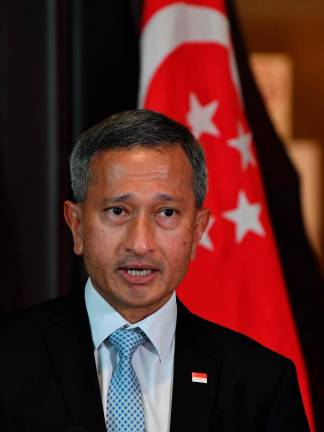THE unprecedented pandemic has served as a wake-up call for us in many aspects, especially in matters related to social safety nets and the need to embrace digitalisation. Many have lost their jobs or been forced to take pay-cuts, leading to job shifts which require certain skill-sets, or else ending up being unemployed or underpaid.
Hence, there is a greater need to pay closer attention to increasing the existing low minimum wage alongside the upskilling of local talents.
The current monthly minimum wage in 56 city councils and municipal council areas has been increased to RM1,200 whereas the minimum wage in other areas was set at RM1,100, effective Feb 1, 2020.
These revisions were made by the former government as part of their manifesto promises to remove the previous disparity in minimum wages between the Peninsular and East Malaysia of RM1,000 and RM920 respectively.
In comparison with other Asean countries, Malaysia’s monthly minimum wage performs better in US dollar terms (US$270-US$295). Thailand’s minimum wage, assuming a six-day work week with eight working hours, ranges US$229 to US$245 across provinces.
Vietnam’s monthly minimum wage ranges lower between US$126 and US$181 while in the Philippines, it ranges between US$129 and US$245.
Despite our minimum wage being high among Asean peers, it is much lower compared with advanced economies such as South Korea and Japan.
Monthly minimum wage in South Korea (in US dollars) is close to five times higher than in Malaysia, whereas Japan’s is around six times higher than Malaysia’s.
Since Malaysia first adopted a minimum wage system in 2013, the increment over the years has not been very significant.
Concerns about low minimum wage are reflected by ground reality, based on EMIR Research’s 3Q20 qualitative findings, with several discussants sharing experiences about getting low wages although their qualifications are high.
A young wage earner pointed out that the salary scale starts from RM1,100 although the person has a degree. “When people say the young ones nowadays are choosy in selecting jobs, I don’t think so.”
Another young degree holder who worked at a private school earning RM1,000 monthly said, “when I asked my friend who works as a cleaner at KLIA, they (cleaners) are paid RM1,800 per month. So, it’s really disturbing”.
“We spent four years of our lives to obtain a degree and we are paid only RM1,000.”
Given the severe economic blow caused by the pandemic, people are trying all means to survive, and some even on a day-to-day basis, especially parents who are trying to make ends meet and ensure their children’s wellbeing.
This explains the public’s persistent request to draw down their savings from their Employees Provident Fund Account 1 as one way to get access to immediate cash for emergencies.
Although this particular wish has been granted with expanded coverage, this relief measure should only be temporary and not as a sustainable and long-term solution.
In line with the notion of equitable shared prosperity, the minimum wage levels that remain low by international standards
need improvement.
Studies have shown that Malaysian workers are not paid appropriately based on the value of their output, and faster growth in labour-intensive industries have continued to keep wages low.
Based on a study done by Bank Negara on the relationship between wage levels and labour productivity across several countries including Malaysia, the correlation between both tends to be positive – the higher the productivity, the higher the wage levels.
Unfortunately, that’s not the case for Malaysia as labour productivity and wage levels are below those of some advanced economies. For example, South Korea is far better in terms of wage levels and productivity due to its continuous efforts in technological development since the 1970s, with average monthly wages surpassing labour productivity. In Malaysia’s case, not only are the wages lower but also workers’ productivity.
Malaysia’s labour share of income lagged at 35.7% of Gross Domestic Product (GDP) in 2018 while for advanced countries such as Singapore, its labour compensation was higher at 39.7% and South Korea’s registered even higher at 45.7%.
Low compensation for employees is significantly evident in sectors which tend to be highly labour-intensive, slow in technological advancements and reliant on low-skilled workers including foreign workers such as those in wholesale and retail trade, food and beverage and accommodation, as well as manufacturing.
These statistics call for improvements in labour skill-sets and productivity which will help workers demand for higher wages.
Bank Negara highlighted the importance of creating demand for high-skilled jobs and pointed out the need to bring in new significant investments in higher-value businesses.
The central bank acknowledged the need to look into existing incentives to attract investments in high innovation economy sectors instead of traditional low-cost manufacturing industries.
An article by author Brendan Duke at the Center for American Progress mentioned a way to raise investments through increasing “aggregate demand” and pointed to studies that suggest increased spending on infrastructure and fiscal incentives (such as low interest rates) for attracting investments.
Duke said an underperforming economy may be boosted through raising demand, which is a relevant point for a depressed economy in light of the pandemic.
Combining the need for high-skilled jobs, it’s clear that attracting investments is not enough to sustain an innovation-centric economy. Shifting to an innovation and technology-driven economy requires mentality and capability change.
The most stable currency to form, sustain and grow an innovative economy is a critical mass of researchers, technology developers, innovators and start-up founders in relevant fields.
Therefore, this requires a revamp of the education system and an integration of innovative culture in government bodies and private sector.
In an innovation-driven economy, the education system supplies talents (push-factor) while the increased demand by innovative businesses (pull-factor) drives the production of more talents by the education system.
This is one example where the talent supply chain can be made more sustainable. An example of such a strong supply and demand system between industry and education can be observed in South Korea whereby it has been ranked as one of the most innovative economies in the world, with high doctorate degree holders per capita.
Sofea Azahar and Ameen Kamal are part of the research team of EMIR Research, an independent think tank focused on strategic policy recommendations based on rigorous research













